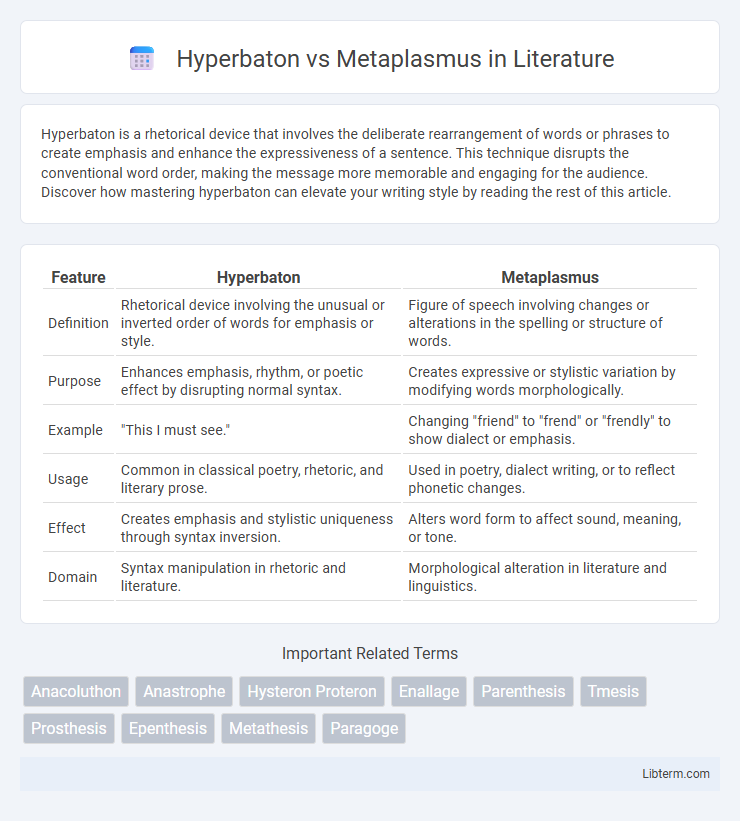Hyperbaton is a rhetorical device that involves the deliberate rearrangement of words or phrases to create emphasis and enhance the expressiveness of a sentence. This technique disrupts the conventional word order, making the message more memorable and engaging for the audience. Discover how mastering hyperbaton can elevate your writing style by reading the rest of this article.
Table of Comparison
| Feature | Hyperbaton | Metaplasmus |
|---|---|---|
| Definition | Rhetorical device involving the unusual or inverted order of words for emphasis or style. | Figure of speech involving changes or alterations in the spelling or structure of words. |
| Purpose | Enhances emphasis, rhythm, or poetic effect by disrupting normal syntax. | Creates expressive or stylistic variation by modifying words morphologically. |
| Example | "This I must see." | Changing "friend" to "frend" or "frendly" to show dialect or emphasis. |
| Usage | Common in classical poetry, rhetoric, and literary prose. | Used in poetry, dialect writing, or to reflect phonetic changes. |
| Effect | Creates emphasis and stylistic uniqueness through syntax inversion. | Alters word form to affect sound, meaning, or tone. |
| Domain | Syntax manipulation in rhetoric and literature. | Morphological alteration in literature and linguistics. |
Introduction to Hyperbaton and Metaplasmus
Hyperbaton is a rhetorical device that involves the deliberate rearrangement of the normal word order to create emphasis or a poetic effect. Metaplasmus, on the other hand, refers to the intentional alteration of the spelling or pronunciation of words to achieve stylistic impact, including insertion, deletion, or substitution of letters. Both techniques serve to enhance linguistic expression by manipulating the structure and form of language elements for artistic or persuasive purposes.
Defining Hyperbaton in Rhetoric
Hyperbaton in rhetoric refers to the deliberate rearrangement of the typical word order within a sentence to create emphasis or achieve a specific stylistic effect. Unlike metaplasmus, which involves the alteration of word forms through letter changes like addition, omission, or substitution, hyperbaton manipulates syntax without altering the words themselves. This figure of speech enhances expressiveness by disrupting normal linguistic expectations, thereby drawing attention to particular elements in discourse.
Understanding Metaplasmus in Linguistics
Metaplasmus in linguistics refers to the deliberate alteration of word forms through insertion, deletion, or substitution of sounds to achieve rhetorical or stylistic effects, such as "thru" for "through." Hyperbaton involves the inversion or unusual arrangement of words in a sentence to emphasize particular elements or create poetic rhythm. Understanding metaplasmus helps in analyzing phonological and morphological changes that shape language evolution and stylistic variation.
Historical Origins of Hyperbaton
Hyperbaton, originating from ancient Greek rhetoric, is a figure of speech involving the inversion or unusual arrangement of word order to create emphasis or poetic effect, extensively used by classical poets like Homer and later by Latin authors such as Cicero. Metaplasmus, in contrast, involves the alteration of words through additions, omissions, or substitutions of letters or sounds, altering a word's form for stylistic or phonetic reasons. While hyperbaton's historical origins trace back to classical antiquity as a deliberate syntactic deviation to enhance expressiveness, metaplasmus is rooted more in phonological transformations than in syntactic rearrangements.
Types of Metaplasmus: Categories and Examples
Metaplasmus encompasses various types such as aphesis, prothesis, epenthesis, and apocope, each involving specific alterations to word structures like omission or insertion of sounds. Aphesis refers to the loss of a short unaccented vowel at the beginning of a word, as in "'cause" from "because," while prothesis involves adding a sound at the start, exemplified by "especial" evolving into "special." Epenthesis inserts an additional sound within a word, such as "athalete" becoming "athlete," and apocope entails dropping a final sound, seen in "photo" from "photograph," all demonstrating metaplasmus' role in linguistic evolution distinct from hyperbaton's syntactic rearrangement.
Key Differences Between Hyperbaton and Metaplasmus
Hyperbaton involves the deliberate inversion or rearrangement of the normal word order in a sentence to create emphasis or a poetic effect, often seen in classical and literary texts. Metaplasmus, on the other hand, refers to the intentional misspelling or alteration of words, including additions, deletions, or substitutions of letters, to convey a particular style, tone, or emphasis. The key difference lies in hyperbaton manipulating syntactic structure while metaplasmus modifies the morphological form of words.
Literary Functions of Hyperbaton
Hyperbaton disrupts the conventional word order to create emphasis and enhance the rhythm, often highlighting important ideas or emotions in literary texts. It engages readers by drawing attention to specific words or phrases, thereby intensifying the overall impact of the narrative or poetry. In contrast, Metaplasmus involves the alteration of word forms to achieve stylistic effects, but does not rearrange syntax as Hyperbaton does to manipulate sentence flow and meaning.
Metaplasmus Techniques in Modern Writing
Metaplasmus techniques in modern writing involve deliberate alterations to the form of words through processes such as insertion, deletion, substitution, or transposition of letters or sounds to achieve stylistic effects or emphasize meaning. Common examples include metathesis, where letters switch places, and anaptyxis, the insertion of a vowel to facilitate pronunciation, enriching the text's phonetic texture and enhancing reader engagement. These modifications often contribute to unique narrative voices or poetic rhythms, distinguishing modern prose and poetry through creative linguistic variation.
Hyperbaton vs Metaplasmus: Comparative Analysis
Hyperbaton involves the deliberate rearrangement of word order to create emphasis or a poetic effect, disrupting the expected syntactic sequence. Metaplasmus entails intentional alteration of a word's form through additions, deletions, or substitutions of letters to achieve stylistic or phonetic impact. While hyperbaton manipulates sentence structure for rhetorical effect, metaplasmus modifies word morphology, highlighting distinct linguistic devices in literary and rhetorical analysis.
Impact of Both Devices on Language and Style
Hyperbaton disrupts conventional word order to create emphasis and heighten dramatic effect, enriching the stylistic complexity of a sentence. Metaplasmus manipulates word forms through phonetic or morphological changes, enhancing expressiveness and tonal variation in language. Both devices intensify meaning and texture, contributing to a dynamic and engaging linguistic style.
Hyperbaton Infographic

 libterm.com
libterm.com